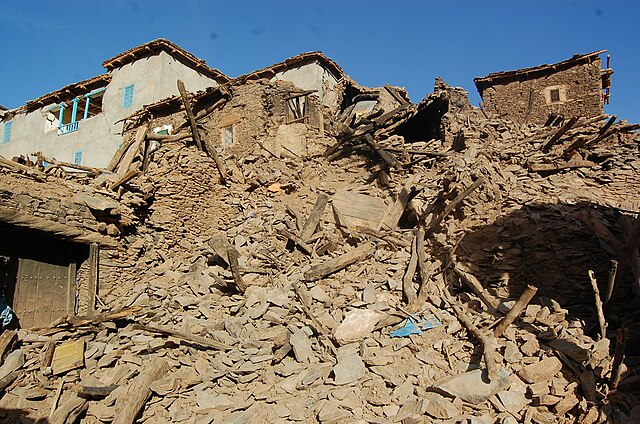A earthquake with a magnitude of 6.8 has recently struck Morocco. Thousands have died from the disaster which has been exacerbated by the negligence of the Moroccan regime. While earthquakes are natural disasters that are not preventable, the state’s response, building codes, and preparation of emergency resources for such an event prescribe such devastating impacts on civilian populations. With decades of local authorities pressuring residents to build earthquake-prone mud homes to maintain their appeal to tourists, and the criminally slow, foot-dragging response of the Moroccan regime, a high human cost and subsequent vocal indignation from the Moroccan people has resulted.
The exact number killed, injured, or missing is not known but according to BBC news the figure stands at over 3,000 killed with 5,530 injured. One local resident told Al-Jazeera that most of the houses in Asna were damaged and in Marrakech, the shocks were so severe that a minaret of one of the city’s mosques collapsed.
The official media of the Moroccan Ministry of the Interior has been carrying out an extensive priming campaign with “special coverage,” involving conversations between experts and specialists. This coverage has almost exclusively emphasized the strength of the earthquake and divine “will and destiny”; in essence diverting blame from government bodies.
What this media coverage additionally dodged were questions about the reasons for such large death tolls, why entire villages were still deprived of medical and food aid after days of the event and the broad incompetence of authorities. While many international governments expressed their condolences to the Moroccan people and their willingness to provide aid, the king of Morocco himself, an individual who never misses an opportunity to promptly congratulate the national football team upon victory, took more than 18 hours to release a statement following this disaster. He was on extended vacation in France and only after critical time had passed was he prompted to have the regime call for a three-day state of mourning. Additionally, the terrifying death toll as well as immense displacement and injury were only worsened by the Moroccan government facilitating NGO aid from only a couple of nations, according to the president of the French NGO Secouristes sans frontières. Although the king justified this by pointing to France’s historic colonial role over the nation, this is clearly an obfuscation considering Mohammed IV’s strong ties to the Macron government and his 1,600 square-meter mansion just outside of Paris. Especially during this crucial period in the week immediately following the earthquake, this blockage of aid has meant that many more lives that could have been salvaged, instead perished.
Rather than relying on the government for help, younger people were at the forefront of mobilizations to help in whatever way they could. Their aid ranged from digging their fellow citizens out of the rubble to volunteering blood. Blood transfusion centers in all cities in the nation have witnessed a large number of volunteers, from Moroccan individuals to and foreign tourists and workers alike.
Ultimately, it is important to note that this deplorably lackluster response is the main cause of Moroccan suffering from this event. Many of the dead or injured could have been saved if the Moroccan regime had focused on its population rather than distortedly reported and sideline priorities. The Moroccan ruling bodies seem to be focused on other adventures like covering the King’s long trips to France and Gabon or its military spending. In 2023 alone, the government raised 120 billion dirhams (~16 billion CAD) for its defense budget, or about 6% of the general budget (the World Health Organization recommends at least 12%). The healthcare industry comparatively raised an amount of 28.12 billion dihams (~3.7 billion CAD), a fraction of the aforementioned amount. This comes as a further surprise with Morocco being is a country not in the middle of a war, having neighbouring countries they are friendly with. This surrounding environment makes such funding aggression unnecessary and inconsiderate.
Furthermore, looking at the preventative side, if there were earthquake-resistant homes, modern infrastructure, forecasting centers, and sufficient investment in medical services, the human deaths from this earthquake would not have been so high. With modern infrastructure lining the city center of Rabat and the King’s palace, the resources are clearly present in the nation; rather their distribution is maliciously flawed. These dwellings are not just a “cultural” either, but as residents and local experts contend is part of a deliberate policy insisted on by the authorities to make sure these villages remain appealing to tourists, eager to experience their ‘quaint, traditional charms’. Mehrdad Sasani, a professor of civil and environmental engineering at Northeastern University, says that the clay-type material used to build homes increases suffocation risk for inhabitants trapped under debris as they do not allow for any air pockets for survivors to continue to breathe. What has happened since the earthquake is a massacre caused by decades of neglect and a system that puts profit before human lives. The governmental palaces did not collapse because they were built with the latest earthquake-proof designs. The structures that did fail were ones of working-class neighborhoods and villages, clearly exposing the true priorities of the Moroccan regime.
Finally, according to the United States Geological Survey, the cost of damages from this deadly earthquake could be as high as 8% of the Moroccco’s GDP. Of course, it is not the ruling government but the working-class taxpayers who will need to fit this bill. The suffering that has been incurred due to the corruption and indifference of Mohammed 6th’s regime will only mount. The first manifestations of this are already coming to fore with the Amizmiz protests in response to the lack of financial support and atrocious conditions of the temporary tent camps. The anger and hatred of the status quo will inevitably reach a tipping point in the class struggle to come. The broader struggle of Moroccans workers and the working class around the world, enables the fight toward a more workers-planned economy; one that takes into account the needs of the producers themselves for the benefit of the whole society and not just the select few at the top.
Edited by Mahnoor Zaman

I am a fourth year political science major interested in journalism and creative writing. I am also very interested in the labour movement and I try to write from the perspective of the labour movement and specifically what are the next steps to further the scope of the movement. I analyze current events and show how we can intervene in them to bring about a fairer society.

